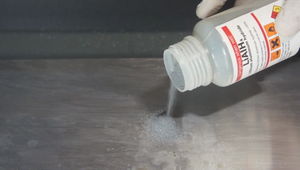Lithium aluminium hydride
 |
This article is a stub. Please help Sciencemadness Wiki by expanding it, adding pictures, and improving existing text.
|
 LiAlH4 being poured from its container
| |
| Names | |
|---|---|
| IUPAC name
Lithium aluminium hydride
| |
| Preferred IUPAC name
Lithium tetrahydridoaluminate(III) | |
| Systematic IUPAC name
Lithium alumanuide | |
| Other names
LAH
Lithal Lithium aluminium hydride Lithium alanate Lithium aluminohydride Lithium tetrahydridoaluminate | |
| Properties | |
| LiAlH4 | |
| Appearance | White or grayish crystals |
| Odor | Odorless |
| Density | 0.917 g/cm3 |
| Melting point | 150 °C (302 °F; 423 K) (decomposes) |
| Boiling point | Decomposes |
| Reacts | |
| Solubility | Soluble in ethers Slightly soluble in dibutyl ether Insoluble in toluene, xylene |
| Solubility in diethyl ether | 11.2332 g/100 ml |
| Solubility in tetrahydrofuran | 39.5 g/100 ml |
| Vapor pressure | ~0 mmHg |
| Thermochemistry | |
| Std molar
entropy (S |
87.9 J·mol-1K-1 |
| Std enthalpy of
formation (ΔfH |
-117 kJ/mol |
| Hazards | |
| Safety data sheet | AcrosOrganics |
| Flash point | 125 °C |
| Related compounds | |
| Related compounds
|
Lithium borohydride |
| Except where otherwise noted, data are given for materials in their standard state (at 25 °C [77 °F], 100 kPa). | |
| Infobox references | |
Lithium aluminium hydride, commonly abbreviated to LAH is an inorganic compound with the chemical formula LiAlH4. It is a strong reducing agent used in organic chemistry.
Contents
[hide]Properties
Chemical
LAH is sensitive to water, and reacts vigorously to release hydrogen.
- LiAlH4 + H2O → LiOH + Al(OH)3 + 4 H2
LAH is metastable at room temperature. During prolonged storage it slowly decomposes to Li3AlH6 and LiH.
LAH is a strong reducing agent, it will convert esters, carboxylic acids, acyl chlorides, aldehydes, and ketones into the corresponding alcohols. Similarly, it converts amide, azide, imine, nitrile, nitro and oxime compounds into amines. LAH is most commonly used for the reduction of esters and carboxylic acids to primary alcohols.
Physical
LAH is a white solid, however commercial samples are usually gray due to impurities. It can be purified by recrystallization from diethyl ether. The pure powdered material is pyrophoric, but its large crystals are not. LAH will react with water to release hydrogen, so samples are usually stored is airtight bags, away from any moisture. LAH is soluble in many ethereal solutions, but is more stable in THF than diethyl ether, even though it's less soluble in the former than the latter.
Availability
LAH is somewhat hard to find, due its sensitivity to air and water. Some people have been able to purchase LAH from Alibaba, from certain chemical sellers. Can also be found on eBay.
Preparation
LAH can be prepared by reacting LiH with anhydrous aluminium chloride, in an aprotic solvent such as diethyl ether. The product is purified by recrystallizing it from diethyl ether.[1] THF can also be used as solvent.
Projects
- Reducing esters to alcohols
- Reduce amides to amines
- Source of hydrogen
Handling
Safety
LAH will react with water to produce lithium hydroxide which is corrosive. It will react with both liquid water as well as the moisture from air. Wear proper protection, like gloves, when handling this compound.
Storage
LAH is best stored in a dry airtight container or bags, under inert or reducing conditions if possible. LAH is also a fire hazard, and in its powdered form can be pyrophoric.
Disposal
The byproducts or neutralizing LAH are lithium and aluminium compounds, usually lithium hydroxide or carbonate and aluminium oxide. They can either be recycled (lithium especially) or disposed in centers that accept aluminium wastes.
See also
References
Relevant Sciencemadness threads
- Article stubs
- Articles containing unverified chemical infoboxes
- Chemical compounds
- Inorganic compounds
- Lithium compounds
- Aluminium compounds
- Hydrogen compounds
- Metal hydrides
- Reducing agents
- Materials unstable in acidic solution
- Materials that react with water
- Air-sensitive materials
- Pyrophoric materials
- Desiccants
- DEA SS List